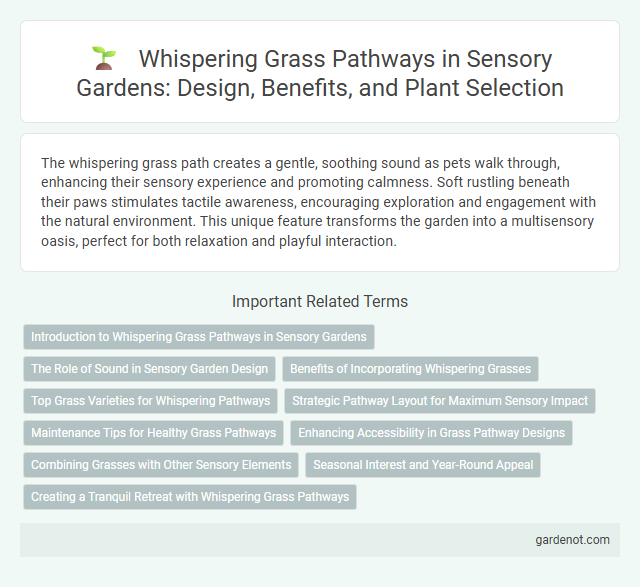The whispering grass path creates a gentle, soothing sound as pets walk through, enhancing their sensory experience and promoting calmness. Soft rustling beneath their paws stimulates tactile awareness, encouraging exploration and engagement with the natural environment. This unique feature transforms the garden into a multisensory oasis, perfect for both relaxation and playful interaction.
Introduction to Whispering Grass Pathways in Sensory Gardens
Whispering Grass Pathways in sensory gardens use tall, slender grasses that sway gently with the breeze, creating soothing rustling sounds that engage auditory senses. These pathways enhance sensory experiences by offering tactile interaction as visitors brush against soft, whispering foliage. Integrating native, low-maintenance grass species supports sustainability while providing a natural, calming environment.
The Role of Sound in Sensory Garden Design
Whispering grass paths enhance sensory gardens by creating immersive auditory experiences that engage visitors through natural sounds. The rustling of tall grasses in the wind produces soothing white noise, which promotes relaxation and mindfulness. Incorporating sound elements like whispering grasses plays a crucial role in stimulating auditory perception and enriching the therapeutic benefits of sensory garden design.
Benefits of Incorporating Whispering Grasses
Whispering grass paths enhance sensory gardens by stimulating auditory and tactile senses through the gentle rustling sound created by the wind. These grasses contribute to mental well-being by promoting relaxation and reducing stress, offering a natural calming effect. Their textured foliage also encourages exploration and interaction, enriching the overall sensory experience.
Top Grass Varieties for Whispering Pathways
Top grass varieties for whispering grass paths include Festuca glauca (blue fescue), known for its soft, fine texture and bluish hues that create soothing rustling sounds as the wind passes through. Carex oshimensis 'Evergold' offers variegated foliage and durable growth, enhancing sensory appeal with its gentle movement. Milium effusum, or wood millet, thrives in shaded areas and produces delicate, whisper-like sounds that enrich the sensory garden experience.
Strategic Pathway Layout for Maximum Sensory Impact
The whispering grass path is designed with a strategic pathway layout that maximizes sensory stimulation through varied textures and gentle rustling sounds. Curved and meandering routes enhance tactile engagement and encourage slow exploration, heightening auditory awareness with each step. Placement near aromatic plants and water features further enriches sensory immersion, creating a dynamic and calming experience.
Maintenance Tips for Healthy Grass Pathways
Regular watering and aeration are essential for maintaining a healthy whispering grass path, ensuring deep root growth and preventing soil compaction. Periodic mowing at a height of 3 to 4 inches promotes dense turf and reduces weed invasion, while fertilizing with a balanced, slow-release formula supports sustained grass vitality. Implementing proper drainage solutions and promptly addressing bare spots with reseeding techniques enhances the durability and aesthetic appeal of sensory garden pathways.
Enhancing Accessibility in Grass Pathway Designs
Whispering grass paths integrate soft, rustling foliage to provide tactile and auditory stimuli, enhancing sensory engagement while ensuring smooth, non-slip surfaces for wheelchair and stroller access. Incorporating contrasting textures and gentle elevations along these grass pathways aids navigation for visually impaired visitors, promoting inclusivity. Strategic planting of low-maintenance, drought-resistant grasses minimizes maintenance while maximizing year-round accessibility and sensory interaction.
Combining Grasses with Other Sensory Elements
The Whispering Grass Path enhances sensory experiences by blending rustling ornamental grasses with fragrant herbs like lavender and rosemary, creating a multi-sensory journey. Textured plantings such as soft moss and scented flowers invite tactile exploration alongside auditory stimulation from the grasses' gentle whispers. Incorporating stones and water features further enriches the path's sensory appeal, engaging sight, sound, and touch harmoniously.
Seasonal Interest and Year-Round Appeal
Whispering grass paths create a dynamic sensory experience through tall, rustling grasses that respond to seasonal changes, offering vibrant green hues in spring and summer and warm golds in autumn. Their rustling sounds enhance tactile and auditory senses, engaging visitors throughout the year. This path maintains aesthetic and sensory appeal in every season, enriching the sensory garden with continuous movement and sound.
Creating a Tranquil Retreat with Whispering Grass Pathways
Whispering grass pathways create a tranquil retreat by gently rustling with the breeze, engaging the senses and promoting relaxation. These soft, textured paths enhance the sensory garden experience by combining natural soundscapes with tactile elements. Integrating whispering grasses along winding trails cultivates a peaceful environment ideal for meditation and quiet reflection.
Whispering grass path Infographic

 gardenot.com
gardenot.com